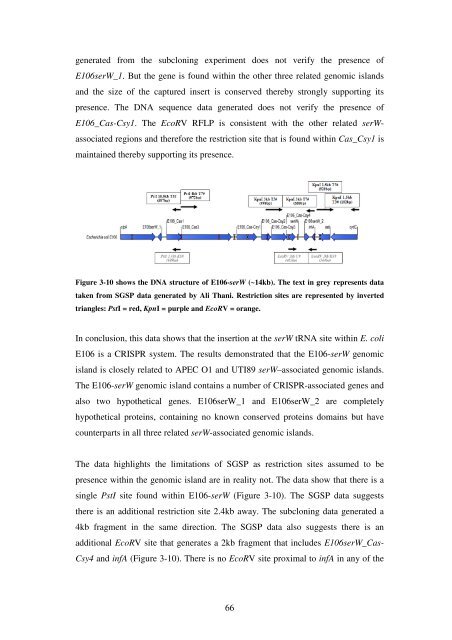5 The role of quorum-sensing in the virulence of Pseudomonas ...
5 The role of quorum-sensing in the virulence of Pseudomonas ...
5 The role of quorum-sensing in the virulence of Pseudomonas ...
You also want an ePaper? Increase the reach of your titles
YUMPU automatically turns print PDFs into web optimized ePapers that Google loves.
generated from <strong>the</strong> subclon<strong>in</strong>g experiment does not verify <strong>the</strong> presence <strong>of</strong><br />
E106serW_1. But <strong>the</strong> gene is found with<strong>in</strong> <strong>the</strong> o<strong>the</strong>r three related genomic islands<br />
and <strong>the</strong> size <strong>of</strong> <strong>the</strong> captured <strong>in</strong>sert is conserved <strong>the</strong>reby strongly support<strong>in</strong>g its<br />
presence. <strong>The</strong> DNA sequence data generated does not verify <strong>the</strong> presence <strong>of</strong><br />
E106_Cas-Csy1. <strong>The</strong> EcoRV RFLP is consistent with <strong>the</strong> o<strong>the</strong>r related serW-<br />
associated regions and <strong>the</strong>refore <strong>the</strong> restriction site that is found with<strong>in</strong> Cas_Csy1 is<br />
ma<strong>in</strong>ta<strong>in</strong>ed <strong>the</strong>reby support<strong>in</strong>g its presence.<br />
Figure 3-10 shows <strong>the</strong> DNA structure <strong>of</strong> E106-serW (~14kb). <strong>The</strong> text <strong>in</strong> grey represents data<br />
taken from SGSP data generated by Ali Thani. Restriction sites are represented by <strong>in</strong>verted<br />
triangles: PstI = red, KpnI = purple and EcoRV = orange.<br />
In conclusion, this data shows that <strong>the</strong> <strong>in</strong>sertion at <strong>the</strong> serW tRNA site with<strong>in</strong> E. coli<br />
E106 is a CRISPR system. <strong>The</strong> results demonstrated that <strong>the</strong> E106-serW genomic<br />
island is closely related to APEC O1 and UTI89 serW–associated genomic islands.<br />
<strong>The</strong> E106-serW genomic island conta<strong>in</strong>s a number <strong>of</strong> CRISPR-associated genes and<br />
also two hypo<strong>the</strong>tical genes. E106serW_1 and E106serW_2 are completely<br />
hypo<strong>the</strong>tical prote<strong>in</strong>s, conta<strong>in</strong><strong>in</strong>g no known conserved prote<strong>in</strong>s doma<strong>in</strong>s but have<br />
counterparts <strong>in</strong> all three related serW-associated genomic islands.<br />
<strong>The</strong> data highlights <strong>the</strong> limitations <strong>of</strong> SGSP as restriction sites assumed to be<br />
presence with<strong>in</strong> <strong>the</strong> genomic island are <strong>in</strong> reality not. <strong>The</strong> data show that <strong>the</strong>re is a<br />
s<strong>in</strong>gle PstI site found with<strong>in</strong> E106-serW (Figure 3-10). <strong>The</strong> SGSP data suggests<br />
<strong>the</strong>re is an additional restriction site 2.4kb away. <strong>The</strong> subclon<strong>in</strong>g data generated a<br />
4kb fragment <strong>in</strong> <strong>the</strong> same direction. <strong>The</strong> SGSP data also suggests <strong>the</strong>re is an<br />
additional EcoRV site that generates a 2kb fragment that <strong>in</strong>cludes E106serW_Cas-<br />
Csy4 and <strong>in</strong>fA (Figure 3-10). <strong>The</strong>re is no EcoRV site proximal to <strong>in</strong>fA <strong>in</strong> any <strong>of</strong> <strong>the</strong><br />
66














